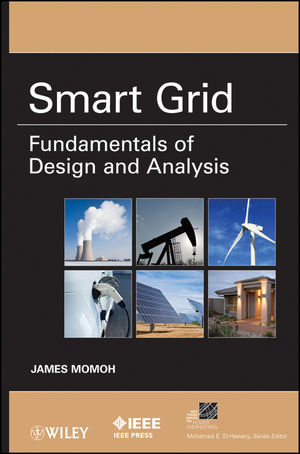Smart Grid: Fundamentals of Design and AnalysisISBN: 978-0-470-88939-8
Hardcover
232 pages
March 2012, Wiley-IEEE Press
 This is a Print-on-Demand title. It will be printed specifically to fill your order. Please allow an additional 10-15 days delivery time. The book is not returnable.
|
||||||
1 SMART GRID ARCHITECTURAL DESIGNS 1
1.1 Introduction 1
1.2 Today's Grid versus the Smart Grid 2
1.3 Energy Independence and Security Act of 2007: Rationale for the Smart Grid 2
1.4 Computational Intelligence 4
1.5 Power System Enhancement 5
1.6 Communication and Standards 5
1.7 Environment and Economics 5
1.8 Outline of the Book 5
1.9 General View of the Smart Grid Market Drivers 6
1.10 Stakeholder Roles and Function 6
1.11 Working Definition of the Smart Grid Based on Performance Measures 11
1.12 Representative Architecture 12
1.13 Functions of Smart Grid Components 12
1.14 Summary 15
2 SMART GRID COMMUNICATIONS AND MEASUREMENT TECHNOLOGY 16
2.1 Communication and Measurement 16
2.2 Monitoring, PMU, Smart Meters, and Measurements Technologies 19
2.3 GIS and Google Mapping Tools 23
2.4 Multiagent Systems (MAS) Technology 24
2.5 Microgrid and Smart Grid Comparison 27
2.6 Summary 27
3 PERFORMANCE ANALYSIS TOOLS FOR SMART GRID DESIGN 29
3.1 Introduction to Load Flow Studies 29
3.2 Challenges to Load Flow in Smart Grid and Weaknesses of the Present Load Flow Methods 30
3.3 Load Flow State of the Art: Classical, Extended Formulations, and Algorithms 31
3.4 Congestion Management Effect 37
3.5 Load Flow for Smart Grid Design 38
3.6 DSOPF Application to the Smart Grid 41
3.7 Static Security Assessment (SSA) and Contingencies 43
3.8 Contingencies and Their Classification 44
3.9 Contingency Studies for the Smart Grid 48
3.10 Summary 49
4 STABILITY ANALYSIS TOOLS FOR SMART GRID 51
4.1 Introduction to Stability 51
4.2 Strengths and Weaknesses of Existing Voltage Stability Analysis Tools 51
4.3 Voltage Stability Assessment 56
4.4 Voltage Stability Assessment Techniques 62
4.5 Voltage Stability Indexing 65
4.6 Analysis Techniques for Steady-State Voltage Stability Studies 68
4.7 Application and Implementation Plan of Voltage Stability 70
4.8 Optimizing Stability Constraint through Preventive Control of Voltage Stability 71
4.9 Angle Stability Assessment 73
4.10 State Estimation 81
5 COMPUTATIONAL TOOLS FOR SMART GRID DESIGN 100
5.1 Introduction to Computational Tools 100
5.2 Decision Support Tools (DS) 101
5.3 Optimization Techniques 103
5.4 Classical Optimization Method 103
5.5 Heuristic Optimization 108
5.6 Evolutionary Computational Techniques 112
5.7 Adaptive Dynamic Programming Techniques 115
5.8 Pareto Methods 117
5.9 Hybridizing Optimization Techniques and Applications to the Smart Grid 118
5.10 Computational Challenges 118
5.11 Summary 119
6 PATHWAY FOR DESIGNING SMART GRID 122
6.1 Introduction to Smart Grid Pathway Design 122
6.2 Barriers and Solutions to Smart Grid Development 122
6.3 Solution Pathways for Designing Smart Grid Using Advanced Optimization and Control Techniques for Selection Functions 125
6.4 General Level Automation 125
6.5 Bulk Power Systems Automation of the Smart Grid at Transmission Level 130
6.6 Distribution System Automation Requirement of the Power Grid 132
6.7 End User/Appliance Level of the Smart Grid 137
6.8 Applications for Adaptive Control and Optimization 137
6.9 Summary 138
7 RENEWABLE ENERGY AND STORAGE 140
7.1 Renewable Energy Resources 140
7.2 Sustainable Energy Options for the Smart Grid 141
7.3 Penetration and Variability Issues Associated with Sustainable Energy Technology 148
7.4 Demand Response Issues 150
7.5 Electric Vehicles and Plug-in Hybrids 151
7.6 PHEV Technology 151
7.7 Environmental Implications 152
7.8 Storage Technologies 154
7.9 Tax Credits 158
7.10 Summary 159
8 INTEROPERABILITY, STANDARDS, AND CYBER SECURITY 160
8.1 Introduction 160
8.2 Interoperability 161
8.3 Standards 163
8.4 Smart Grid Cyber Security 166
8.5 Cyber Security and Possible Operation for Improving Methodology for Other Users 173
8.6 Summary 174
9 RESEARCH, EDUCATION, AND TRAINING FOR THE SMART GRID 176
9.1 Introduction 176
9.2 Research Areas for Smart Grid Development 176
9.3 Research Activities in the Smart Grid 178
9.4 Multidisciplinary Research Activities 178
9.5 Smart Grid Education 179
9.6 Training and Professional Development 182
9.7 Summary 183
10 CASE STUDIES AND TESTBEDS FOR THE SMART GRID 184
10.1 Introduction 184
10.2 Demonstration Projects 184
10.3 Advanced Metering 185
10.4 Microgrid with Renewable Energy 185
10.5 Power System Unit Commitment (UC) Problem 186
10.6 ADP for Optimal Network Reconfiguration in Distribution Automation 191
10.7 Case Study of RER Integration 196
10.8 Testbeds and Benchmark Systems 197
10.9 Challenges of Smart Transmission 198
10.10 Benefits of Smart Transmission 198
10.11 Summary 198
References 199
11 EPILOGUE 200
Index 203



